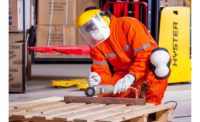The number of construction nonfatal injuries rose slightly last year but the industry’s injury rate improved, the federal Bureau of Labor Statistics has reported.
The latest annual BLS report on workplace injuries and illnesses, released on Nov. 7, shows that construction nonfatal injuries totaled 199,100 in 2018, an increase of less than 1% from 198,100 the year before. The upturn, though small, follows two straight years of reductions in the number of construction injuries. [View 2018 story with several years' data here.]
The industry’s nonfatal injury-illness rate declined to 3.0 per 100 workers last year, from a 3.1 rate in 2017.
That continues a steadily improving trend over the past five years in construction’s nonfatal injury rate. That figure dipped from 3.6 in 2014 to 3.5 in 2015, then to 3.2 in 2016 and 3.1 in 2017.

The number of nonfatal construction injuries and illnesses rose 1.9% in 2015, to 204,700 but had been improving since then. The total declined to 203,500 in 2016 and 198,100 in 2017 before turning up last year.
Chris Trahan Cain, North America’s Building Trades Unions safety and health director, also points out that the number of construction injury cases resulting in days away from work—a subset of the nonfatal total—fell nearly 3% last year to 77,500.
Cain noted via email that the days away from work incidents “tend to reflect more-serious injuries.” She added, “This drop is good news.”
In the nonresidential construction segments that the Associated Builders and Contractors monitors, the injury/illness rate has dipped from about 5.0 about a decade ago to 2.9 in 2018, says Greg Sizemore, ABC vice president for health, safety, environment and workforce development.
Sizemore said in an interview, "When I see data like that, it's very encouraging." He adds, "For us, it just speaks volumes about that we continue to get safer and safer."
Sizemore sees the BLS figures as a "lagging indicator." He adds, "We've got to do more...to promote the leading indicators."
He's referring to such steps as daily "toolbox" safety talks on jobsites, for example, at the start of the workday or at lunch. ABC's most recent annual safety performance report, released in May, showed that toolbox sessions were the most effective such indicator, reducing Total Recordable Incident Rates by 85% compared with the use of monthly toolbox meetings.
Strong substance-abuse programs or policies reduced the recordable incident rate by 60% compared with companies with "weaker" programs.
The BLS report also showed that construction's nonfatal rate still was higher than the rate for all private employers, which held at 2.0 per 100 workers, the same as in 2017.
The overall number of nonfatal injury and illness cases rose by 23,000 in 2018, to 2.83 million, an increase of less than 1%, BLS says.
The data come from employers’ reports to the Dept. of Labor.
Story corrected on 11/08/2019 to say that the report covers injuries and illnesses. Story updated on 11/11/2019 to include comments from Associated Builders and Contractors.




Post a comment to this article
Report Abusive Comment